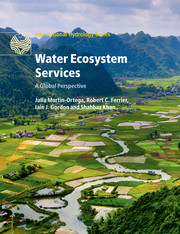Book contents
- Frontmatter
- Contents
- List of contributors
- Preface
- 1 Introduction
- 2 What defines ecosystem services-based approaches?
- Part I Addressing global challenges
- Part II Applying frameworks for water management and biodiversity conservation under an ecosystem services-based approach
- Part III Assessing water ecosystem services
- Part IV Broadening the perspective
- Index
- Plate Section
- References
1 - Introduction
Published online by Cambridge University Press: 05 May 2015
- Frontmatter
- Contents
- List of contributors
- Preface
- 1 Introduction
- 2 What defines ecosystem services-based approaches?
- Part I Addressing global challenges
- Part II Applying frameworks for water management and biodiversity conservation under an ecosystem services-based approach
- Part III Assessing water ecosystem services
- Part IV Broadening the perspective
- Index
- Plate Section
- References
Summary
Fresh water is vital for the function of all terrestrial ecosystems – the flora and the fauna that make up those ecosystems, and, of course, for humans. Humanity relies on water not just for drinking, but also for food production, dealing with waste, providing energy and transport, to name but a few. To meet its needs humanity harnesses water through dams, irrigation networks, and pumps and pipes that supply drinking water and remove wastes. It is estimated that humanity consumes 1000–1700 m3 of the globe's surface and groundwater resources per year; that is between 22% and 150% of the annual global supply of fresh water (Hoekstra & Wiedmann 2014). This proportion is likely to increase as the global human population increases in the next 30 years and the demands for water in developing countries catches up with that of developed countries. According to the Intergovernmental Panel on Climate Change, changes in climate will amplify existing stress on water availability and will exacerbate different forms of water pollution, with impacts on ecosystems, human health, and water system reliability in large parts of the world (Stocker et al. 2013).
For a number of years, academics have tried to understand the linkages between the water system and human needs and the impacts that anthropogenic activities have on the water system itself. In the early days, the scientific approach sat within individual domains (e.g. hydrology for the water cycle (Thompson 1999); ecology for ecological impacts of water pollution (Abel 1996)). Given the complexity of the interactions and the centrality of humans in the water environment, more recently interdisciplinary approaches have come to the fore (e.g. Ferrier & Jenkins 2010; Renaud & Kuenzer 2014). The latest of such approaches is what we define in this book as ecosystem services-based approaches. These encompass a range of ways of understanding, assessing, and managing ecosystems at which core is the notion of ecosystem services, understood as the benefits that humans obtain from ecosystems.
- Type
- Chapter
- Information
- Water Ecosystem ServicesA Global Perspective, pp. 1 - 2Publisher: Cambridge University PressPrint publication year: 2015
References
- 1
- Cited by

